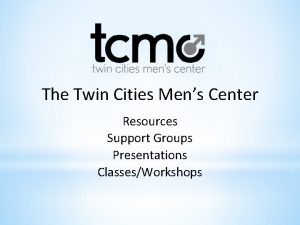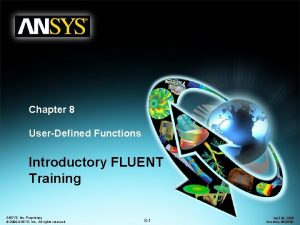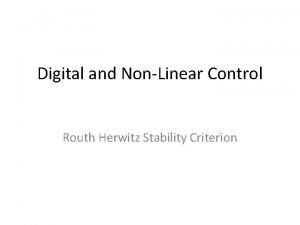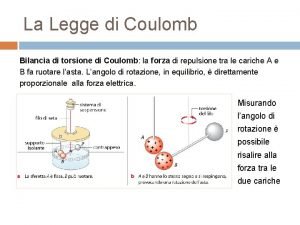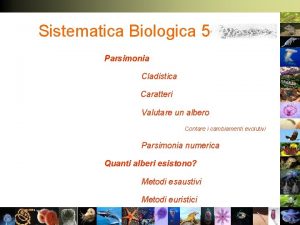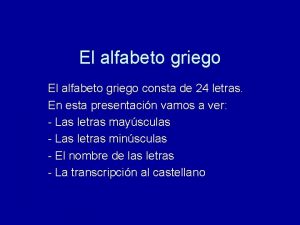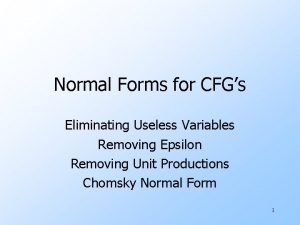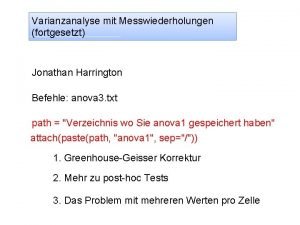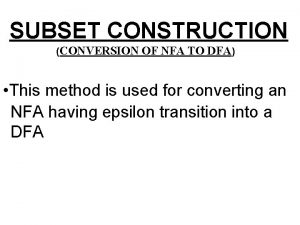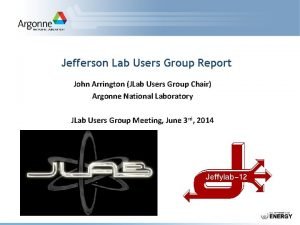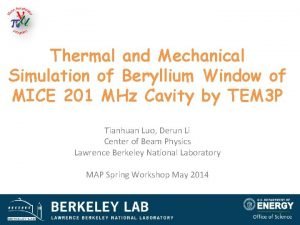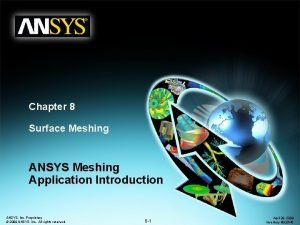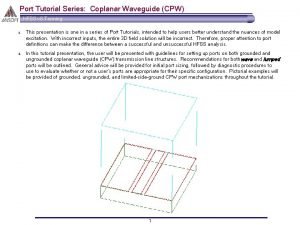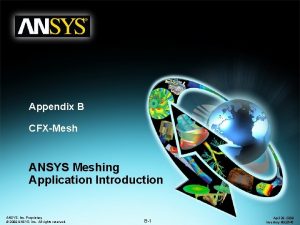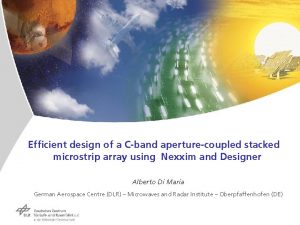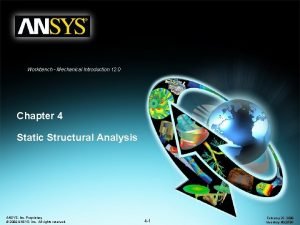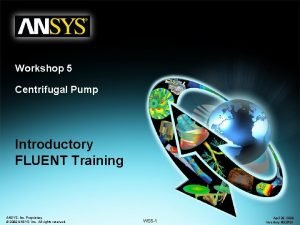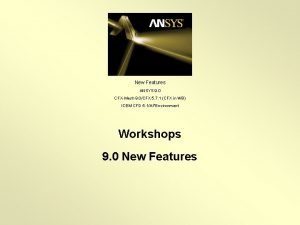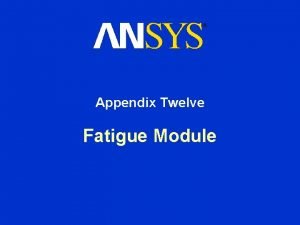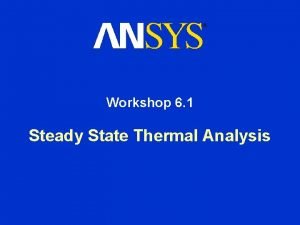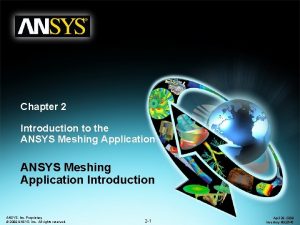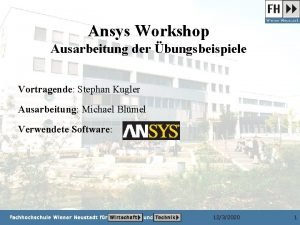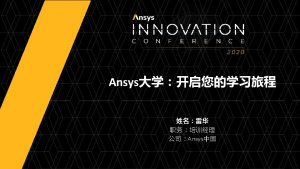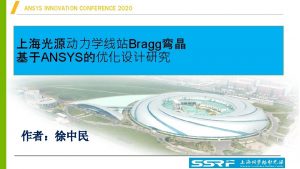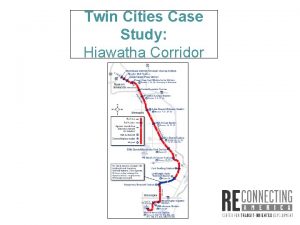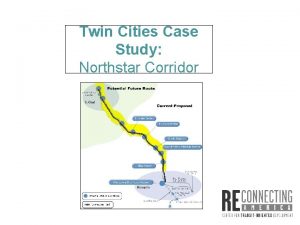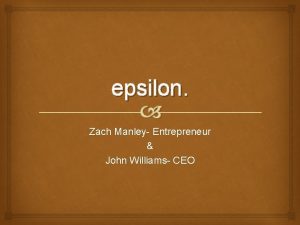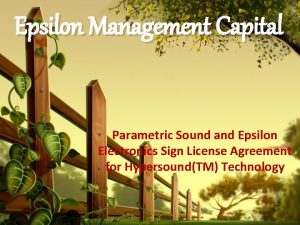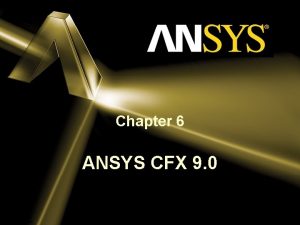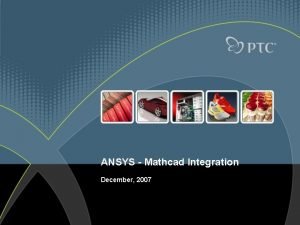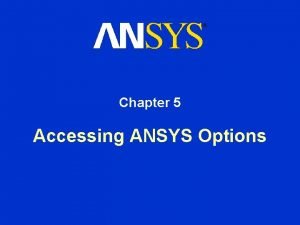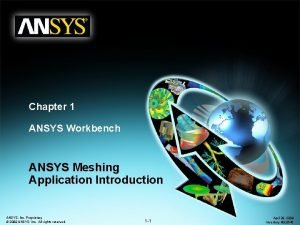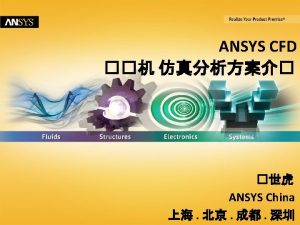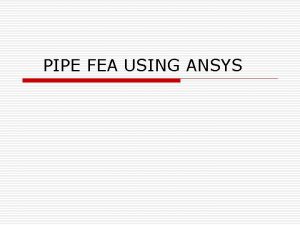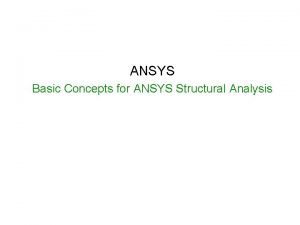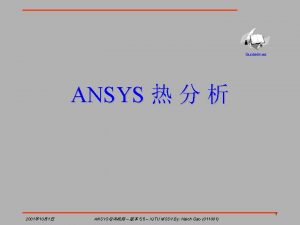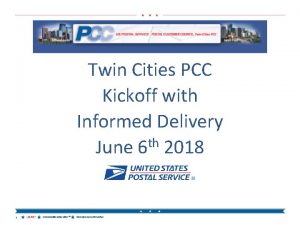within Epsilon Twin Cities ANSYS User Meeting June











































- Slides: 43

… within Epsilon Twin Cities ANSYS® User Meeting June 2018 Nonlinear Adaptivity … within Epsilon

… within Epsilon 1. 2. 3. 4. 5. Agenda Epsilon FEA Introduction Nonlinear Adaptivity Overview Nonlinear Adaptive Mesh Procedure Nonlinear Adaptivity Case Studies Q&A ANSYS User Meeting 2

… within Epsilon Intro to Epsilon • Epsilon FEA provides engineering analysis (10 yrs!) • Making Simulation Accurate – In-depth knowledge of the tools • ANSYS® Suite of Multi-Physics software – Experience with industry successes/failures • Aerospace, Rotating Machinery, Electronics, Manufacturing, Packaging, etc. – We validate with calibration runs and hand-calcs • Experienced Assessing Discretization Error • Making Simulation Affordable – – Low hourly rates and/or fixed-price estimates We use specialized experienced engineers Detailed statements of work, scope and budget tracking Automation (APDL, ACT, Journaling) ANSYS User Meeting 3

… within Epsilon’s Customers • Our customers need load-leveling with: – Analyst is a team-member, not a black-box • Interface with same Epsilon analyst to leverage past experiences r i it ! l a c C – Open and frequent communication – Any new FEA methods/lessons learned are well communicated – Schedule/budget fidelity with frequent status updates • Achieved by using the right person, tools, and technical approach • Our customers benefit from external expertise – We infuse up-to-date FEA methods/tools • Leverage other industries’ FEA innovations – We are not a software reseller • Unbiased tool selection, infrastructure advice – We share our knowledge, files, and lessons learned! ANSYS User Meeting 4

… within Epsilon Nonlinear Adaptive Region • For large deflection analyses with high element distortion • Reported to resolve convergence issues with high element distortions, esp. plasticity & elastomers • Automated form of mesh rezoning • A few adaptive mesh criteria exist – Will focus on mesh quality • Limitations apply ANSYS User Meeting 5

… within Epsilon Nonlinear Adaptivity • Implemented during Solution options – Define subset of timesteps to check • less computation time – Multiple criteria options • mesh quality • strain energy • bounding box – Only remeshes when criteria is met and only remeshes in problem areas ANSYS User Meeting 6

… within Epsilon Adaptive Mesh: Limitations • Must use tetrahedral elements for 3 D bodies – Can be linear (SOLID 285 s) or quadratic (SOLID 187 s) – Quadratic tet capability is new in V 19 – Quadratic elements recommended • Scope to solid bodies or elements only (3 D or 2 D planar) – no shells • Altered mesh cannot be shared between linked analyses • May introduce solution chatter that would otherwise not be present • Instabilities can cause convergence issues ANSYS User Meeting 7

… within Epsilon Adaptive Mesh: Limitations Cannot be used in combination with the following features/conditions on the same part: • • • Cyclic Symmetry Contact Formulations: Normal Lagrange (3 D), MPC, and Beam Contact Behaviors: Auto Asymmetric Point Mass, Beam Connection, Joints, Spring, and Bearing Remote Force, Remote Displacement, Moment, Thermal Condition, and Remote Point • Spatially varying boundary conditions • Coupling • Constraint Equation Same limitations as in R 16. From ANSYS V 16 Release Notes ANSYS User Meeting 8

… within Epsilon Adaptive Meshing: Procedure • With environment selected in the tree, insert Nonlinear Adaptive Region or select it from the Conditions toolbar • Can only be scoped to a body or named selection of elements • Select criterion and time range to check upon Can specify time range to speed up solution ANSYS User Meeting 9

… within Epsilon Adaptive Meshing: Procedure • Required Analysis Settings: – Large Deflection = On – Store Results = All Time Points – Note: If Large Deflection = Off or Store Results ≠ All Time Points, a ? will appear next to the Nonlinear Adaptive Region object, and it will not be obvious as to why. – Click the Show Errors Button to troubleshoot ANSYS User Meeting 10

… within Epsilon Adaptive Meshing: Procedure • Auto Time Stepping – Default Auto Time Step settings are often adequate for material nonlinearities without nonlinear adaptivity – For nonlinear adaptivity, auto time stepping should be manually specified to obtain desired adaptivity – Be generous with number of time steps • Some test cases would succeed with the relatively large default 1 st step, but encounter problems later ANSYS User Meeting 11

… within Epsilon Adaptive Meshing: Procedure • Scoping: Geometry or Named Selection – When Scoping Method is set to Geometry, Body, Node, Element Face, and Element selection filters are available. Body filter is the only valid one. – Must create a Named Selection from elements to scope to elements • Mechanical will allow scoping to a Hex-Meshed Body – No mesh adaptivity will occur ANSYS User Meeting 12

… within Epsilon Adaptive Meshing: Procedure • Criterion = Energy, Box, or Mesh – Energy is used to improve accuracy of crack growth modeling based on strain energy – Box dictates the location of elements to be split after deformation. • Uses coordinate locations on any elements entering the region. • Typically used to model seating of a seal undergoing high deformation – Mesh monitors mesh quality throughout load event and remeshes when elements become overly distorted. – We will focus on Mesh criterion herein ANSYS User Meeting Energy Criterion Box Criterion 13

… within Epsilon Adaptive Meshing: Procedure • Mesh Criterion Options – Skewness • • Reflects “flatness” of element Valid for linear and quadratic elements 0 is perfectly shape; 1 is completely flat Default Skewness Value = 0. 9; recommended skewness = 0. 9 - 0. 95 Skewness = 0 Skewness approaching 1 – Jacobian Ratio • • Reflects if element is turning inside-out Valid for quadratic elements only 1 is ideal; 0 is threshold; < 0 is inside-out Default Jacobian = 0. 1; recommend Jacobian = 0. 01 – 0. 15 Jacobian = 1 – Note that Skewness and Jacobian are normalized values in ANSYS Jacobian approaching zero ANSYS User Meeting 14

… within Epsilon Jacobian Ratio Warning • Jacobian ratio criterion applies to quadratic elements only – – Only skewness criterion applies to linear elements, Jacobian ignored Warning message will display regardless of scope ANSYS User Meeting 15

… within Epsilon Adaptive Meshing: Procedure • Mesh Check Frequency – Check At = Equally Spaced Points (default) • Checks mesh quality for rezoning need at Value time points between Start and End Time. – Specified Recurrence Rate • Checks mesh quality at every Valueth substep • Recommended ANSYS User Meeting 16

… within Epsilon Adaptive Meshing: Results Check force/displacement convergence graphs or tabular data to find which time step/substep a remesh was applied ANSYS User Meeting 17

… within Epsilon Adaptive Meshing: Results Compare pre-mesh change and post-mesh change substeps to find regions of improvement ANSYS User Meeting 18

… within Epsilon Case Study 1 a: Metal Forming • 1” thick, 3” radius disk is crushed in the center by a 1” radius forming tool. (1/4 symmetry model) • Element size = Default (0. 23) • 301 ¼ hard bilinear isometric material model • Compare linear and quadratic models, with and without nonlinear adaptive regions Determine amount of crush before convergence failure ANSYS User Meeting 19

… within Epsilon Case Study 1 a: Metal Forming • Metal forming summary of findings – Note stress results were similar, even with poorly shaped elements for no NLAD Consider activating only if required! ANSYS User Meeting 20

Case Study 1 b: Linear vs Quadratic … within Epsilon • • L-shaped bracket 200, 000 psi applied to top flange Fixed at bottom Compare results for linear and quadratic elements ANSYS User Meeting 21

Case Study 1 b: Linear vs Quadratic … within Epsilon Linear vs Quadratic Element Results • Even with mixed U-P formulation, 4 -noded elements are too stiff. • Before NLAD, mixed U-P formulation was our best tool (besides smaller time steps). • Use quadratic elements with nonlinear adaptivity now that the option is available. ANSYS User Meeting 22

Case Study 1 b: Linear vs Quadratic … within Epsilon Linear Quadratic ANSYS User Meeting 23

… within Epsilon • • Case Study 2 a: L-Bracket L-shaped bracket: 301 ¼ hard, BISO plasticity Pressure applied to top flange Fixed at bottom Determine maximum pressure model will converge at with and without the nonlinear adaptive region 0. 5” thick Element size = 0. 1” Element size = 0. 03” 0. 1” fillet 2” x 1” ANSYS User Meeting 24

… within Epsilon Case Study 2 a: L-Bracket • Study effect of improving mesh quality by reducing element growth rate from fine to coarse vs using a nonlinear adaptive region. Element growth rate = 1. 85 (default) ANSYS User Meeting Element growth rate = 1. 85 (default) 25

… within Epsilon Case Study 2 a: L-Bracket maximum pressure results Adaptivity? Growth Rate Max Pressure Elapsed Time Max Strain Number Remeshes No 1. 85 1. 4 GPa 2. 8 min 50% N/A No 1. 20 2. 1 GPa 18. 0 min 63% N/A Yes 1. 85 3. 4 GPa 35. 7 min 78% 32 Adjusting growth rate improved convergence behavior, but not as much as nonlinear adaptivity. Both approaches introduce significant time cost. ANSYS User Meeting 26

… within Epsilon • • Case Study 2 b: L-Bracket L-shaped bracket: 301 ¼ hard, BISO plasticity 400, 000 pressure applied to top flange Fixed at bottom Determine effect of various settings on solve performance 0. 5” thick Element size = 0. 1” Element size = 0. 03” 0. 1” fillet 2” x 1” ANSYS User Meeting 27

… within Epsilon Case Study 2 b: L-Bracket L-bracket nonlinear adaptive results animations ANSYS User Meeting 28

… within Epsilon Case Study 2 b: L-Bracket L-bracket solve performance results • Best performance was with Recurrence Rate = 1 and Nonlinear Adaptive Region scoped to entire body. • This is consistent with our other case studies. ANSYS User Meeting 29

… within Epsilon • • Case Study 2 c: L-Bracket MISO L-shaped bracket: 301 ¼ hard, MISO plasticity 400, 000 pressure applied to top flange Fixed at bottom Determine effect of various settings on solve performance 0. 5” thick Element size = 0. 1” Element size = 0. 03” 0. 1” fillet 2” x 1” ANSYS User Meeting 30

… within Epsilon Case Study 2 c: L-Bracket, MISO • Without NLAD, fails at 34% strain – Initial step size was not a factor • Adding NLAD, fails at 82% strain – Initial step size was not a factor ANSYS User Meeting 31

… within Epsilon Case Study 3: Membrane Loads • Studies were performed on three cases in which loading was primarily in the membrane or axial direction – Axially loaded beam – Pressure vessel – Pulling of a cylindrical boss attached to a cylinder ANSYS User Meeting 32

… within Epsilon Case Study 3: Membrane Loads • In no case did nonlinear adaptivity significantly improve converge behavior; perhaps by a small amount, but with a drastic time cost • Convergence failure in each case appeared to be due to unstable materials rather than excessive element distortion ANSYS User Meeting 33

… within Epsilon Case Study 4: Slivers • What happens when a nonlinear adaptive region includes slivers, such as two cylindrical components tangent to one another • What corrective actions can be taken? ANSYS User Meeting 34

… within Epsilon Case Study 4: Slivers • Nonlinear adaptivity scoped to whole body, recurrence rate = 1 Wow. Adaptive rezoning is occurring in a region where satisfactory element shape quality is impossible due to the sliver regions ANSYS User Meeting 35

… within Epsilon Case Study 4: Slivers • Possible correction: Scope adaptivity to Named Selection of elements away from sliver region. ANSYS User Meeting 36

… within Epsilon Case Study 4: Slivers • Possible correction: Add fillets or blend the sliver out using other repair methods. Note: This method did not converge nearly as well for this test case as scoping the Nonlinear Adaptive Region to a Named Selection did. ANSYS User Meeting 37

… within Epsilon Case Study 5: Contact & Elongation • Bending SS 304 bar over rigid pin using frictionless Augmented La. Grange contact • Both bilinear and multilinear plasticity tested • NL Adaptive region criteria set to default values – Skewness of 0. 9, Jacobian of 0. 1 – Energy coefficient of 1 • Check for remesh at all converged substeps ANSYS User Meeting 38

… within Epsilon Case Study 5: Deformations Linear Elements No Remeshing Linear Elements Mesh Criterion Linear Elements Energy Criterion Linear Elements Multilinear Quad Elements No Remeshing Quad Elements Mesh Criterion Quad Elements Energy Criterion Quad Elements Multilinear ANSYS User Meeting 39

… within Epsilon Case Study 5: Results Element Type Material Property Remesh Criterion No. of Remeshes Max % Plastic Strain Linear Bilinear None 0 88. 4% Linear Bilinear Mesh 19 99. 7% Linear Bilinear Energy 2 14. 2% Linear Multilinear Mesh 8 80% Quadratic Bilinear None 0 103% Quadratic Bilinear Mesh 20 137% Quadratic Bilinear Energy* 4 12. 8% Quadratic Multilinear Mesh 0 4. 6% Quadratic Multilinear Mesh 10 109% Quadratic Multilinear None 0 141% Quadratic Neohookean Mesh 19 68% Quadratic Neohookean None 0 69% Small stepsize *Solve ended due to extremely large element count using all hard disk space. Recommend a non-default setting specific to your application. ANSYS User Meeting 40

… within Epsilon Conclusions 1. NLAD well addresses the element distortion errors 2. NLAD typically require more time to solve, but can be faster and more robust than trying to adjust the mesh. 3. A recurrence rate of 1 has shown to be an optimal mesh check rate in these test cases, (note the ANSYS recommending a recurrence rate of 2) – your mileage may vary. 4. Manual specification of auto time stepping values is strongly recommended and necessary in most cases. 5. NLAD performs better on distortion due to compression or bending than stretching ANSYS User Meeting 41

… within Epsilon Conclusions 6. Fine tuning of criteria and load stepping usually required – Especially with energy criterion 7. Scoping the Nonlinear Adaptive Region to a named selection did not decrease the solution time, – Yet useful for avoiding regions in which the mesh will inherently be poorly shaped. 8. Adaptive regions have less of an effect on, and are less necessary for, quadratic elements than linear elements – Yet very useful for models with extreme material and geometric nonlinearities. 9. Slivers are still problematic. 10. NLAD well addresses element distortion errors. Repeats item 1, but let’s end on a high note! ANSYS User Meeting 42

… within Epsilon Input / Questions ANSYS User Meeting 43
 Rumus twin twin
Rumus twin twin Monochorionic monoamniotic twins
Monochorionic monoamniotic twins Men's center
Men's center Dcma twin cities
Dcma twin cities Ansys fluent user defined function
Ansys fluent user defined function Routh
Routh Costanti dielettriche tabella
Costanti dielettriche tabella Onda epsilon
Onda epsilon Epsilon 0
Epsilon 0 Epsilon
Epsilon ε-amino
ε-amino 9 letra del alfabeto griego
9 letra del alfabeto griego Provehito in altum translation
Provehito in altum translation Remove epsilon productions
Remove epsilon productions Sigma alpha epsilon colors
Sigma alpha epsilon colors Sigma lambda epsilon
Sigma lambda epsilon Greenhouse geisser korrektur
Greenhouse geisser korrektur Rizol gamma
Rizol gamma Grcka slova fizika
Grcka slova fizika Construction of epsilon nfa from regular expression
Construction of epsilon nfa from regular expression Onda epsilon displasia aritmogena
Onda epsilon displasia aritmogena Aka sigma epsilon omega
Aka sigma epsilon omega Finite automata with epsilon transitions
Finite automata with epsilon transitions Nfa to dfa using subset construction
Nfa to dfa using subset construction Single user and multiple user operating system
Single user and multiple user operating system Operating systems
Operating systems Jefferson lab sol
Jefferson lab sol Jlab user group meeting
Jlab user group meeting What is meeting and types of meeting
What is meeting and types of meeting For today's meeting
For today's meeting Types of meeting
Types of meeting Meeting objective
Meeting objective Ansys simulation
Ansys simulation Ansys inflation
Ansys inflation Coplanar
Coplanar Virtual topology ansys
Virtual topology ansys Ansys nexxim
Ansys nexxim Compression only support ansys
Compression only support ansys Centrifugal pump ansys
Centrifugal pump ansys Ansys
Ansys Fatigue tool ansys
Fatigue tool ansys Ansys steady state thermal
Ansys steady state thermal Ansys element quality
Ansys element quality Ansys seminar
Ansys seminar


